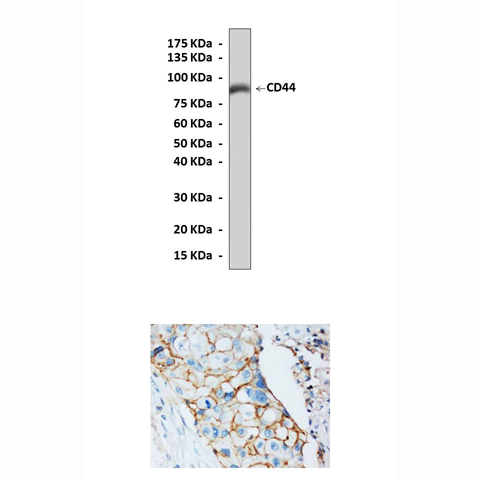Anti-CD44: Polyclonal Homing Cell Adhesion Molecule, H-CAM, Antibody |
 |
BACKGROUND CD44 is a ubiquitous multistructural and multifunctional cells surface adhesion molecule involved in cell-cell and cell-matrix interactions. Twenty exons are involved in the genomic organization of this molecule. The first five and the last 5 exons are constant, whereas the 10 exons located between these regions are subjected to alternative splicing, resulting in the generation of a variable region. Differential utilization of the 10 variable region exons, as well as variations in N-glycosylation, O-glycosylation, and glycosaminoglycanation (by heparan sulfate or chondroitin sulfate), generate multiple isoforms (at least 20 are known) of different molecular sizes (85-230 kDa). The smallest CD44 molecule (85-95 kDa), which lacks the entire variable region, is standard CD44 (CD44s). As it is expressed mainly on cells of lymphohematopoietic origin, CD44s is also known as hematopoietic CD44 (CD44H). CD44s is a single-chain molecule composed of a distal extracellular domain (containing, the ligand-binding sites), a membrane-proximal region, a transmembrane-spanning domain, and a cytoplasmic tail. The molecular sequence (with the exception of the membrane-proximal region) displays high interspecies homology. After immunological activation, T lymphocytes and other leukocytes transiently upregulate CD44 isoforms expressing variant exons (designated CD44v). A CD44 isform containing the last 3 exon products of the variable region (CD44V8-10, also known as epithelial CD44 or CD44E), is preferentially expressed on epithelial cells. The longest CD44 isoform expressing in tandem eight exons of the variable region (CD44V3-10) was detected in keratinocytes.1 Hyaluronic acid (HA), an important component of the extracellular matrix (ECM), is the principal, but by no means the only, ligand of CD44. Other CD44 ligands include the ECM components collagen, fibronectin, laminin, and chondroitin sulfate. Mucosal addressin, serglycin, osteopontin, and the class II invariant chain are additional, ECM-unrelated, ligands of the molecule. In many, but not in all cases, CD44 does not bind HA unless it is stimulated by phorbol esters, activated by agonistic anti-CD44 antibody, or deglycosylated (e.g., by tunicamycin).2 The cytoplasmic domain of CD44 communicates with the cytoskeleton via ankyrin and proteins belonging to the ezrin-moesin-radixin family. Relatively little is known about the intracellular events following interactions of CD44 with its ligands.3 CD44 is a multifunctional receptor involved in cell-cell and cell-ECM interactions, cell traffic, lymph node homing, presentation of chemokines and growth factors to traveling cells, and transmission of growth signals. CD44 also participates in the uptake and intracellular degradation of HA, as well as in transmission of signals mediating hematopoiesis and apoptosis. Many cancer cell types as well as their metastases express high levels of CD44. Whereas some tumors, such as gliomas, exclusively express standard CD44, other neoplasms, including gastrointestinal cancer, bladder cancer, uterine cervical cancer, breast cancer and non-Hodgkin's lymphomas, also express CD44 variants. Hence CD44, particularly its variants, may be used as diagnostic or prognostic markers of at least some human malignant diseases.4
REFERENCES
1. Liang X.: et al. Am J Clin Payhol.: 117(2): 276-282, 2001
2. Hefler, L.A.: et al.: Cancer.: 94(1): 125-130, 2002
3. Masaki, T.: et al.: Cancer.: 92(10): 2539-2546, 2001
2. Hefler, L.A.: et al.: Cancer.: 94(1): 125-130, 2002
3. Masaki, T.: et al.: Cancer.: 92(10): 2539-2546, 2001
Products are for research use only. They are not intended for human, animal, or diagnostic applications.
Параметры
Cat.No.: | CA0321 |
Antigen: | N-terminal sequence of human CD44 |
Isotype: | Affinity-purified rabbit polyclonal IgG |
Species & predicted species cross- reactivity ( ): | Human, Rabbit, Rat, Mouse |
Applications & Suggested starting dilutions: | WB 1:500 - 1:1000 IP n/d IHC (Paraffin) 1:50 - 1:200 ICC n/d FACS n/d |
Predicted Molecular Weight of protein: | 86 kDa |
Specificity/Sensitivity: | Anti-CD44 reacts specifically with CD44 of human, mouse & rat origin in immunohistochemistry (membrane staining) and western blotting, no cross-reactivity with other members of the CAM family. |
Storage: | Store at 4° C for frequent use; at -20° C for at least one year. |
*Optimal working dilutions must be determined by end user.
Документы
|
| ||||||||||
| ||||||||||
Информация представлена исключительно в ознакомительных целях и ни при каких условиях не является публичной офертой








